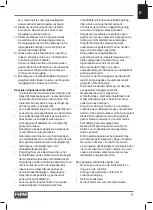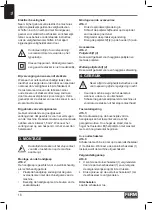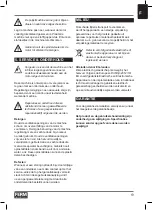
6
EN
p) Do not use accessories that require liquid
coolants. Using water or other liquid coolants
may result in electrocution or shock.
Kickback and Related Warnings
Kickback is a sudden reaction to a pinched or
snagged rotating wheel, backing pad, brush or
any other accessory. Pinching or snagging causes
rapid stalling of the rotating accessory which in
turn causes the uncontrolled power tool to be
forced in the direction opposite of the accessory’s
rotation at the point of the binding.
For example, if an abrasive wheel is snagged or
pinched by the workpiece, the edge of the wheel
that is entering into the pinch point can dig into the
surface of the material causing the wheel to climb
out or kick out. The wheel may either jump toward
or away from the operator, depending on direction
of the wheel’s movement at the point of pinching.
Abrasive wheels may also break under these
conditions.
Kickback is the result of power tool misuse and/or
incorrect operating procedures or conditions and
can be avoided by taking proper precautions as
given below.
a) Maintain a firm grip on the power tool and
position your body and arm to allow you to resist
kickback forces. Always use auxiliary handle,
if provided, for maximum control over kickback
or torque reaction during start-up. The operator
can control torque reactions or kickback forces,
if proper precautions are taken.
b) Never place your hand near the rotating acces-
sory. Accessory may kickback over your hand.
c) Do not position your body in the area where
power tool will move if kickback occurs.
Kickback will propel the tool in direction
opposite to the wheel’s movement at the point
of snagging.
d) Use special care when working corners, sharp
edges etc. Avoid bouncing and snagging the
accessory. Corners, sharp edges or bouncing
have a tendency to snag the rotating accessory
and cause loss of control or kickback.
e) Do not attach a saw chain woodcarving blade
or toothed saw blade. Such blades create
frequent kickback and loss of control.
Special safety instructions
• Check that the maximum speed indicated on
the disc corresponds to the maximum speed
of the machine. The speed of the machine
must not exceed the value on the disc.
• Make sure that the dimensions of the disc cor-
res pond to the specifications of the machine.
• Make sure that the disc has been mounted
and fastened properly. Do not use reducing
rings or adapters to make the disc fit properly.
• Never use this machine single handed. Always
use both hands to operate the machine.
• Do not touch any rotating parts.
• Make sure the wool bonnet is not contacting
the workpiece before the machine is switched
on.
• Do not touch the workpiece immediately after
operation. It may be hot.
• Warning: The wheel still rotates after the
machine has been switched off
• Hold the machine by the insulated grips when
performing an operation where contact can be
made with hidden wiring or its own cord.
• Before use, inspect the disc for any damage.
Do not use discs which are crack-ed, ripped or
otherwise damaged.
• Before use, let the machine run idle for 30
seconds. Immediately switch off the machine
in case of abnormal vibrations or occurrence
of another defect. Carefully inspect the
machine and disc before switching the
machine on again.
• Always wear safety goggles and hearing
protection.
• Ensure that mounted wheels and points are
fitted in accordance with the manufacturer’s
instructions.
• For tools intended to be fitted with threaded
hole wheel, ensure that the thread in the
wheel is long enough to accept the spindle
length.
• Ensure that ventilation openings are kept clear
when working in dusty conditions. If it should
become nessesary to clear dust, first
disconnect the tool from the mains supply (use
non metallic objects) and avoid damaging
internal parts.
• Though poor conditions of the electrical
mains, shortly voltage drops can appear when
starting the equipment. This can influence
other equipment (eq. blinking of a lamp). If the
Summary of Contents for AGM1120P
Page 2: ...2 Fig 1 Fig 2 Fig 3 3 5 4 1 6 2...
Page 3: ...3 Fig 4 Fig 5 Fig 6 A B 5 3 4...
Page 120: ...120 RU 180 M14 3 3 Lpa 86 3 A Lwa 97 3 A 3 51 1 5 2 EN 60745 1 1 2 3 U 4 5 6 2 O a b c...
Page 121: ...121 RU d e f g h i j k l m n o p...
Page 122: ...122 RU a b c d e 30...
Page 123: ...123 RU II 1 5 2 3 2 3 4 5 4 3 4 4...
Page 124: ...124 RU 5 6 1 1 6 1 1 6 1 5...
Page 125: ...125 UK 2012 19 EU 1400W 180mm 3 2 3 1 2 3 4 5 1 220 240 V 50 Hz 1400 1000 3300 180 M 14...
Page 126: ...126 UK 3 3 Lpa 86 3 A Lwa 97 3 A 3 51 1 5 2 EN 60745 1 1 2 3 U 4 5 6 2 a b c d e...
Page 127: ...127 UK f g h i j k l m n o p...
Page 128: ...128 UK a b c d e 1 5 2 30...
Page 129: ...129 UK 1 5 2 3 2 3 4 5 4 3 4 4 5 6 1 1 6 1 1 6 1...
Page 130: ...130 UK 5 2012 19 EU...
Page 132: ...132 EL l...
Page 133: ...133 EL...
Page 134: ...134 EL O 30 Zmax 0 348 Ohm...
Page 135: ...135 EL A H N II 1 5 mm2 3 2 3 4 5 4 3 A 4 4 5...
Page 136: ...136 EL 6 On Off 1 On Off 1 6 On Off 1 On Off 1 6 On Off 1 5 2012 19 EU...
Page 143: ...143 MK a b c c d max e f g 1 min h i j k...
Page 144: ...144 MK l m n o p a b c d e max max f...
Page 145: ...145 MK 30 s Zmax 0 348 1 5 mm2 3 2 3 5 5 4 3 4...
Page 146: ...146 MK 4 5 6 1 1 6 1 6 1 A 7 7 5...
Page 147: ...147 MK 2012 19 EU...
Page 149: ...149 Exploded view...
Page 150: ...150...
Page 152: ...WWW FERM COM 2020 FERM 2005 19...







































